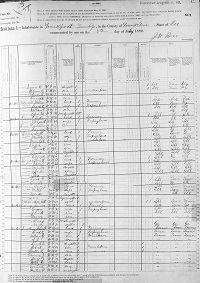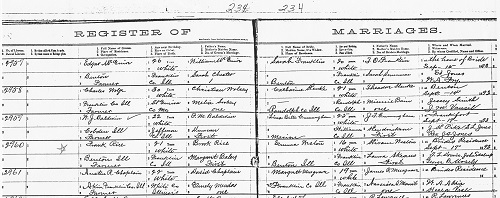
 William
Franklin RICE was born 18 Nov 1871 in Benton, Franklin County,
Illinois, to Charles Brooks and Margaret (BAILEY) RICE.
By 1920, he went by the name 'Frank Rice.'
William
Franklin RICE was born 18 Nov 1871 in Benton, Franklin County,
Illinois, to Charles Brooks and Margaret (BAILEY) RICE.
By 1920, he went by the name 'Frank Rice.'
"William Franklin Rice and a twin sister named Frances were born in Franklin County, near Benton, IL to (Charles) Brooks Rice and Margaret Bailey Rice. He had an older sister, Rhoda, and three older half-brothers. His father died when he was five, and his mother died when he was seven." [*FHA]
"One half-brother, Arthur, stowed away on a sailing ship to England. Frank and his sisters were then cared for by Taylor and Margaret (SUMMERS) GARRETT (Aunt Peg) strictly for the work they could do. There were many chores but limited food and clothing for the children. He had only one pair of boots at a time, which, on a growing boy, were most of the time too small. His boots were hand made with the soles attached with small wooden pegs. When they got wet, by the time the leather dried, it was difficult to get them on or walk in them for a while because they would shrink so in drying. He went barefoot all summer until he was grown. He had rabbit traps which were 'run' each morning. During the cold weather he would take hot rocks with him to stand on while he tended each trap because he had no adequate winter clothing." [*FHA]
"Although he did not received schooling beyond the Fifth Grade, he read a lot and obtained general knowledge for himself. As soon as he was old enough to make his own way, he worked as a farrnhand and any other work he could get." [*FHA]
 "On
17 Sep 1893, at the age of 22, he was married to
Emma Caroline WESTON,
who also lived near Benton. After he paid the Minister, he had $1.00 left." [*FHA]
"On
17 Sep 1893, at the age of 22, he was married to
Emma Caroline WESTON,
who also lived near Benton. After he paid the Minister, he had $1.00 left." [*FHA]
Frank and Emma had eight children: Chester Paul (1894), Barney Tilbert (1895), Artie Tecumseh (1898), Beulah Gertrude (1900), Emma Mae (1903), Harry Franklin (1905), Verbal Marie (1908), and Wilma Lorene (1913).
"Their first child, Chester Paul, died when he was six and a half months old. A few years after their marriage, they moved with their two small sons, Barney and Artie, to Poplar Bluff, Missouri. They went to Missouri in a horse-drawn wagon with Mr. Rice’s older sister, Rhoda, and her husband on his persuasion that farming there would be easier and more profitable. However, it was not and the only work Mr. Rice could get was cutting railroad ties for a dollar a day. They remained in Missouri for about a year, then returned to Benton, Illinois, where he worked as a farmer." [*FHA]
1900 Census
Frank Rice family home
1909 vs 1914
in Johnston City, Williamson County, Illinois
1910 Census
Johnston City, Williamson County, Illinois
1920 Census
Johnston City, Williamson County, Illinois
1930 Census
Melrose Park, Cook County, Illinois
1940 Census
Pope County, Illinois
"In 1902 they moved to Johnston City in Williamson County, Illinois, a small town which formed the nucleus and supplied the workers for the six or seven bituminous coal mines that surrounded the town. He began working in one of the mines. This was hard, dangerous work during those early years of coal mining when there were few safety measures taken for the workers. It was rare that a miner escaped injury of some sort if he spent even a few years in the mine. Frank Rice was no exception. He sustained a serious back injury and on another occasion a head injury from falling coal. Protective hard-hats were unheard of at that time. The miners wore cloth caps with bills on which were hooked their lamps, the only means of lighting in the pitch black mine hundreds of feet underground." [*FHA]
"In the earlier days of mining, the miner’s lamp burned a wick and a wax similar to candle wax. It was hooked on the bill of the cap and resembled a small teakettle. Later the carbide lamp was invented. The carbide was encased in a round brass 'jar' about two inches wide and two inches high. Carbide was placed in the bottom, and a small amount of water in the top. When the water dripped slowly onto the carbide, it produced gas from which the flame burned surrounded by a reflector. The flame could be regulated by the amount of water allowed to reach the carbide. The open flames of the lamps were apt to ignite the gasses that accumulated and violent explosions were frequent in which many men were injured or killed. There was one miners’ hospital, a local hospital with a contract with the mine owners, to serve a two or three county area consisting of perhaps ten or fifteen active mines, so only the most critical injuries were treated in the hospital. Other injured men were taken home to be cared for by their families under a family doctor’s care." [*FHA]
"When the miners came up from the mine they were covered all over with fine black dust. There were small wash shacks dotted over the mine property where two to four men bathed in wash tubs, carrying their own hot water from the boiler room of the mine. Since most of the mines were located away from the town itself, and automobiles were scarce even in high income families, most of the miners walked to and from the mine, which meant that they walked about three miles each way through pasture land and fields to and from work, in hot summer, in rain, snow, and subzero temperatures." [*FHA]
"Almost every year, during the entire summer, the mines would be on strike, which meant there would be no income during all the summer months. Frank Rice was secretary of the 'Local' and during these strikes some of the miners would come to him for small allotments previously set aside for this purpose, thereby providing their families with a bare subsistence during the strike." [*FHA]
"During one of the periods of 'growing pains' in the mining industry, the mine managers disregarded the strike action and imported laborers to load the coal. These imports were mostly uninformed, uneducated, often Italians, etc., who could not speak or understand English. This resulted in what became known as a 'bloody vendetta.' Books have been written about this uprising, and the name and reputation remained long with southern Illinois, especially 'Bloody Williamson County.' There was an actual shooting war as miners fought for their rights to strike for reasonable wages and working conditions. The entire area was in a state of suspense and fear for months. Frank Rice worked as a special police during this outbreak. On one occasion, he was guarding the front of the jail where an Italian man was being held under arrest for killing someone. While he and another man guarded the front of the jail, a group of men slipped into the jail at the back entrance and took the man out and hanged him." [*FHA]
"Frank Rice served as City Alderman on two different occasions, which paid him $25 every three months. He served for awhile as County Overseer of the Poor, which was a form of county welfare. He investigated needy families and allocated county funds for this use." [*FHA]
"He liked people and had many friends. He made it a practice never to say things against others. He liked to fish and hunt, especially wild squirrels, and would often be in the woods by daylight when the squirrels started out to feed. The Rice family and their friends would go on overnight fishing trips together. He joined and was active in the Odd Fellows Lodge, and attended the Methodist Church." [*FHA]
"In about 1920, Frank Rice and his wife, Emma Caroline Weston Rice, separated (although they were never divorced). Frank moved to a small community, Hurt-Bush, which was also built for the Bush mine. While there, he joined the Masonic Lodge. He stayed in Bush until the beginning of the Depression. In 1928 he went to Melrose Park, a suburb of Chicago, where he was employed in a factory. He lived there with his oldest daughter, Beulah Gertrude RICE LAWRENCE, and her family until 1934 when he purchased a house and 90 acres of farmland in Pope County in the southern part of Illinois." [*FHA]
"For the first two years he lived in Pope County, his oldest daughter and family also lived about three-fourths of a mile 'across the way.' In the late summer of 1935 his oldest son, Barney, came to live with him. Barney was ill with tuberculosis and passed away the following 15 Mar 1936. Two years later, 10 Sep 1938, the neighboring son-in-law, Loy Horace Lawrence, was killed by lightening and the daughter moved back to Johnston City. Frank lived alone, but his children were able to visit him at least once a month until he died." [*FHA]
"Although this was a sparsely populated area, with no neighbors visible in any direction, he was very content here. The house was an old farm house with one large room and a smaller kitchen. There was a large fireplace in one end of the large room but it was inadequate for the cold winter weather, so he purchased a wood-burning stove and supplied additional heat from logs cut from the timber surrounding the house. He raised chickens and sold eggs, as well as the separated cream from his cows. He and his neighbors thought nothing of walking three or four miles over hilly fields to visit and help each other with various chores. It was too far from town for electricity but he had a battery-operated radio. Except in impassable weather, he rode with some of the neighbors weekly into the little country town of Eddyville to purchase supplies and pick up mail at the post office." [*FHA]
"Frank Rice was always ready to help his children in any way he could. Even when they were married or gone from home, he would deny himself in order to help any of them during a crisis." [*FHA]
"He became ill during the early part of 1945 and in July his family moved him to a hospital where his illness was diagnosed as cancer. He was not happy in the hospital, so was moved to the family home in Johnston City where he passed away on 23 Jul 1945. The heritage he left his children was one of uncomplaining acceptance and adjustment to life, and great, great courage." [*FHA]
Frank Rice was buried in the Weston family lot at the Masonic and Odd Fellows Cemetery in Benton, Franklin County, Illinois.
23 Jul 1945
Blk. C, Lot 14, Sp. 8
Inter. No. 5739
Masonic &
Oddfellows Cemetery
Benton, Franklin County, Illinois
[*FHA Family History April 1964 probably written by Janet Banwart ]
Many of the pictures displayed are small versions.
Simply click on the image to see an enlargement.
Our thanks to Marsha Bryant for graciously hosting this HASS Family History website on her server.